ACC302 - Auditing and Assurance: Comprehensive Case Study Analysis
VerifiedAdded on 2022/08/25
|8
|1604
|24
Case Study
AI Summary
This case study analysis examines several scenarios related to auditing and assurance. The first scenario involves Beast Ltd. and its use of the Last-In, First-Out (LIFO) method for inventory valuation, leading to an unqualified audit opinion. The second case analyzes the audit report of SecondBite Foundation by Grant Thornton Audit Ply Ltd., highlighting the lack of internal auditors and resulting in a qualified opinion. The third scenario involves Golddiggers Pty Ltd., where manipulation of financial reports by a landowner led to an adverse opinion due to missing information. Finally, the fourth case focuses on Ms. Pit, the finance director, who refused to adopt Australian Accounting Standards Board (AASB) 124 / IAS 24 related-party disclosure standards, resulting in a qualified opinion. The analysis covers the implications of each case, including the types of audit opinions and the importance of adhering to accounting standards.
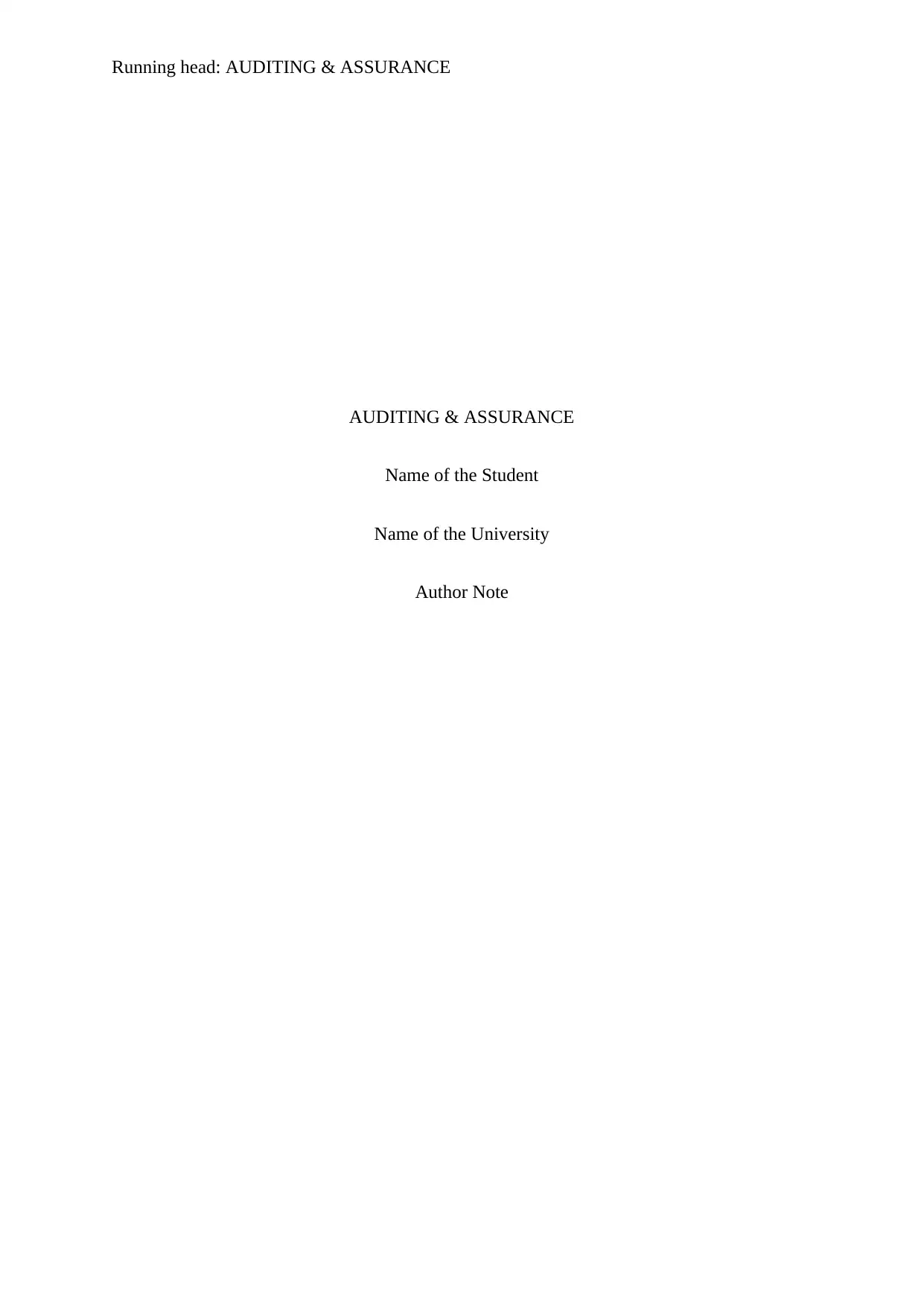
Running head: AUDITING & ASSURANCE
AUDITING & ASSURANCE
Name of the Student
Name of the University
Author Note
AUDITING & ASSURANCE
Name of the Student
Name of the University
Author Note
Paraphrase This Document
Need a fresh take? Get an instant paraphrase of this document with our AI Paraphraser
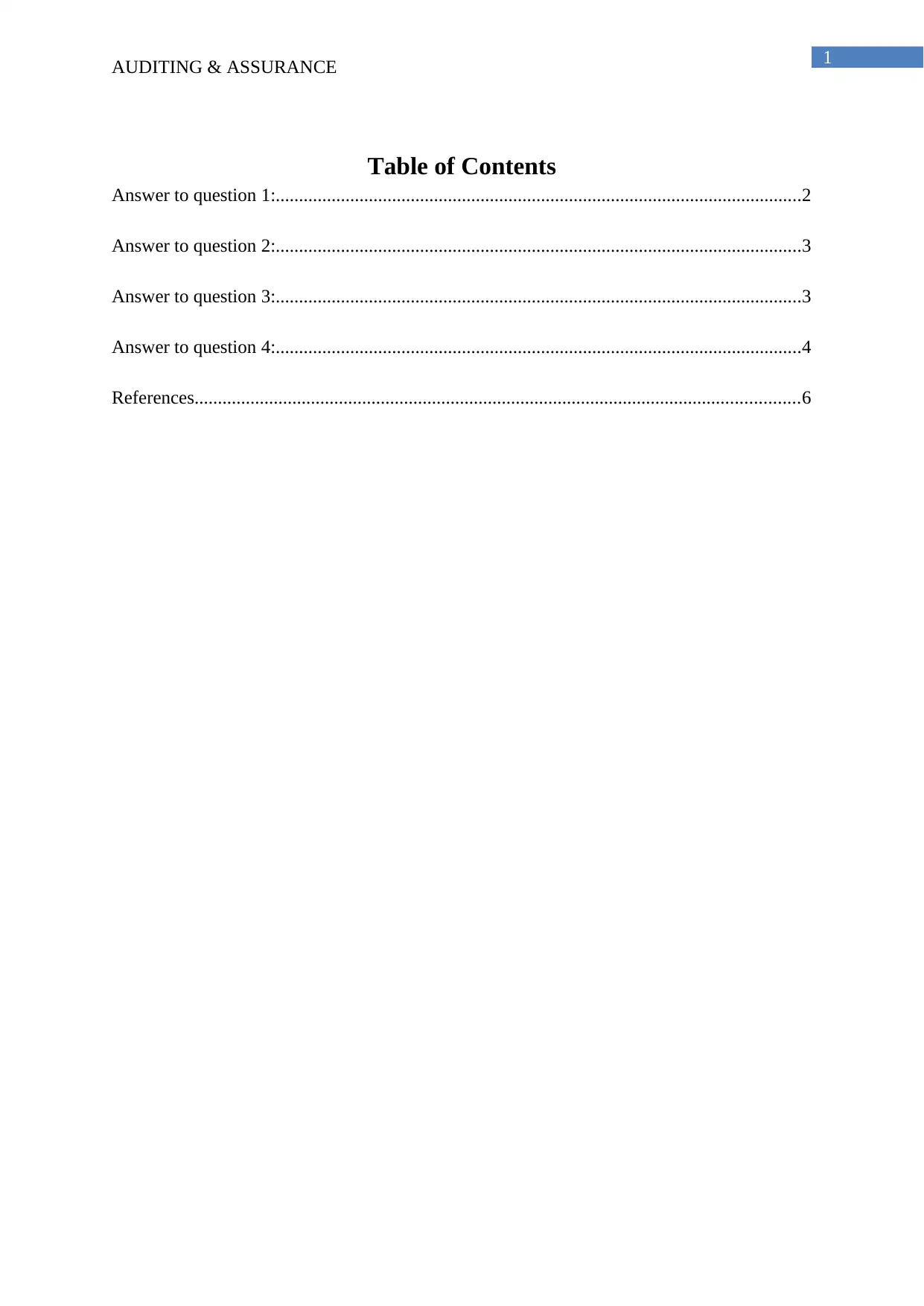
1
AUDITING & ASSURANCE
Table of Contents
Answer to question 1:.................................................................................................................2
Answer to question 2:.................................................................................................................3
Answer to question 3:.................................................................................................................3
Answer to question 4:.................................................................................................................4
References..................................................................................................................................6
AUDITING & ASSURANCE
Table of Contents
Answer to question 1:.................................................................................................................2
Answer to question 2:.................................................................................................................3
Answer to question 3:.................................................................................................................3
Answer to question 4:.................................................................................................................4
References..................................................................................................................................6
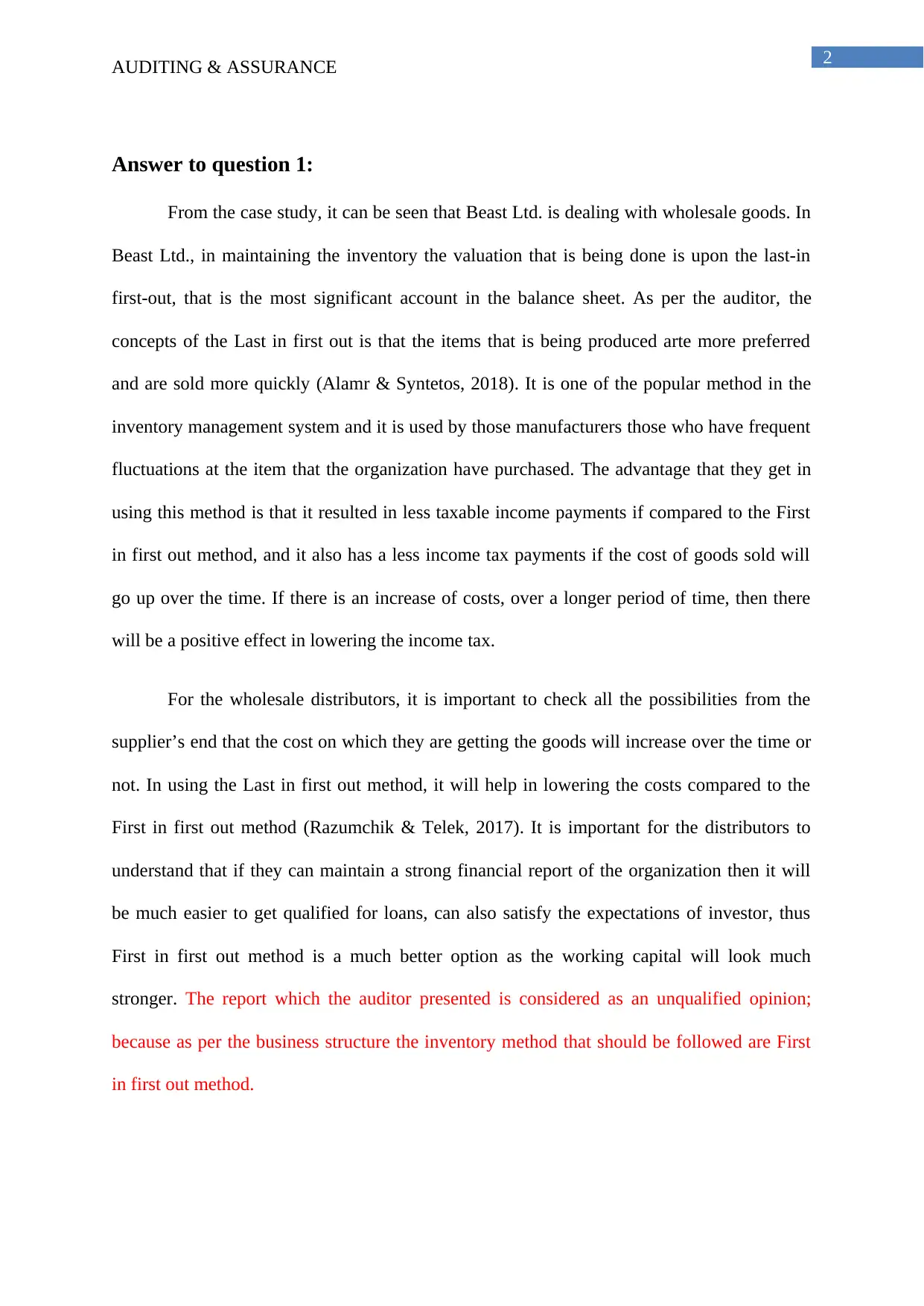
2
AUDITING & ASSURANCE
Answer to question 1:
From the case study, it can be seen that Beast Ltd. is dealing with wholesale goods. In
Beast Ltd., in maintaining the inventory the valuation that is being done is upon the last-in
first-out, that is the most significant account in the balance sheet. As per the auditor, the
concepts of the Last in first out is that the items that is being produced arte more preferred
and are sold more quickly (Alamr & Syntetos, 2018). It is one of the popular method in the
inventory management system and it is used by those manufacturers those who have frequent
fluctuations at the item that the organization have purchased. The advantage that they get in
using this method is that it resulted in less taxable income payments if compared to the First
in first out method, and it also has a less income tax payments if the cost of goods sold will
go up over the time. If there is an increase of costs, over a longer period of time, then there
will be a positive effect in lowering the income tax.
For the wholesale distributors, it is important to check all the possibilities from the
supplier’s end that the cost on which they are getting the goods will increase over the time or
not. In using the Last in first out method, it will help in lowering the costs compared to the
First in first out method (Razumchik & Telek, 2017). It is important for the distributors to
understand that if they can maintain a strong financial report of the organization then it will
be much easier to get qualified for loans, can also satisfy the expectations of investor, thus
First in first out method is a much better option as the working capital will look much
stronger. The report which the auditor presented is considered as an unqualified opinion;
because as per the business structure the inventory method that should be followed are First
in first out method.
AUDITING & ASSURANCE
Answer to question 1:
From the case study, it can be seen that Beast Ltd. is dealing with wholesale goods. In
Beast Ltd., in maintaining the inventory the valuation that is being done is upon the last-in
first-out, that is the most significant account in the balance sheet. As per the auditor, the
concepts of the Last in first out is that the items that is being produced arte more preferred
and are sold more quickly (Alamr & Syntetos, 2018). It is one of the popular method in the
inventory management system and it is used by those manufacturers those who have frequent
fluctuations at the item that the organization have purchased. The advantage that they get in
using this method is that it resulted in less taxable income payments if compared to the First
in first out method, and it also has a less income tax payments if the cost of goods sold will
go up over the time. If there is an increase of costs, over a longer period of time, then there
will be a positive effect in lowering the income tax.
For the wholesale distributors, it is important to check all the possibilities from the
supplier’s end that the cost on which they are getting the goods will increase over the time or
not. In using the Last in first out method, it will help in lowering the costs compared to the
First in first out method (Razumchik & Telek, 2017). It is important for the distributors to
understand that if they can maintain a strong financial report of the organization then it will
be much easier to get qualified for loans, can also satisfy the expectations of investor, thus
First in first out method is a much better option as the working capital will look much
stronger. The report which the auditor presented is considered as an unqualified opinion;
because as per the business structure the inventory method that should be followed are First
in first out method.
⊘ This is a preview!⊘
Do you want full access?
Subscribe today to unlock all pages.

Trusted by 1+ million students worldwide
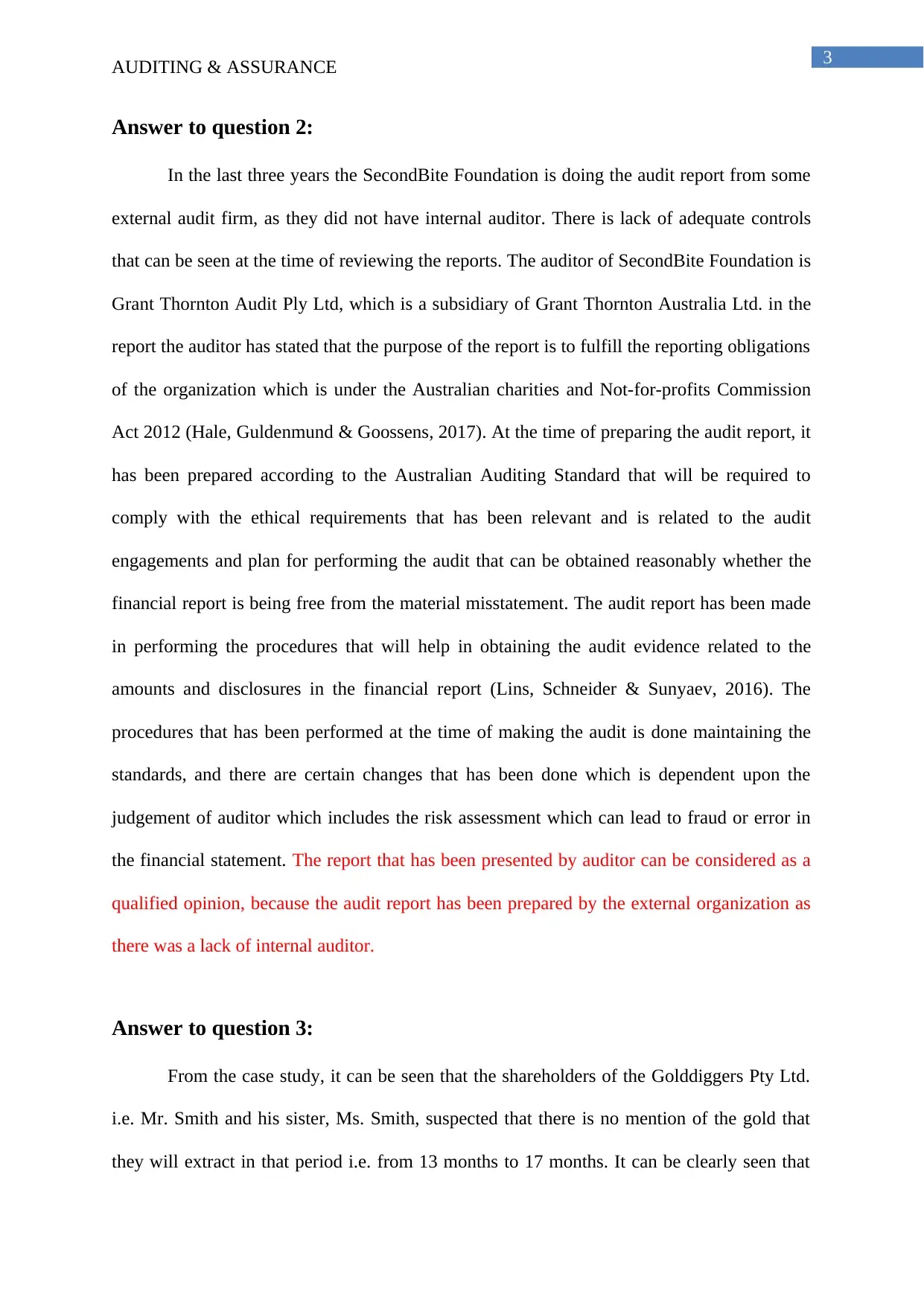
3
AUDITING & ASSURANCE
Answer to question 2:
In the last three years the SecondBite Foundation is doing the audit report from some
external audit firm, as they did not have internal auditor. There is lack of adequate controls
that can be seen at the time of reviewing the reports. The auditor of SecondBite Foundation is
Grant Thornton Audit Ply Ltd, which is a subsidiary of Grant Thornton Australia Ltd. in the
report the auditor has stated that the purpose of the report is to fulfill the reporting obligations
of the organization which is under the Australian charities and Not-for-profits Commission
Act 2012 (Hale, Guldenmund & Goossens, 2017). At the time of preparing the audit report, it
has been prepared according to the Australian Auditing Standard that will be required to
comply with the ethical requirements that has been relevant and is related to the audit
engagements and plan for performing the audit that can be obtained reasonably whether the
financial report is being free from the material misstatement. The audit report has been made
in performing the procedures that will help in obtaining the audit evidence related to the
amounts and disclosures in the financial report (Lins, Schneider & Sunyaev, 2016). The
procedures that has been performed at the time of making the audit is done maintaining the
standards, and there are certain changes that has been done which is dependent upon the
judgement of auditor which includes the risk assessment which can lead to fraud or error in
the financial statement. The report that has been presented by auditor can be considered as a
qualified opinion, because the audit report has been prepared by the external organization as
there was a lack of internal auditor.
Answer to question 3:
From the case study, it can be seen that the shareholders of the Golddiggers Pty Ltd.
i.e. Mr. Smith and his sister, Ms. Smith, suspected that there is no mention of the gold that
they will extract in that period i.e. from 13 months to 17 months. It can be clearly seen that
AUDITING & ASSURANCE
Answer to question 2:
In the last three years the SecondBite Foundation is doing the audit report from some
external audit firm, as they did not have internal auditor. There is lack of adequate controls
that can be seen at the time of reviewing the reports. The auditor of SecondBite Foundation is
Grant Thornton Audit Ply Ltd, which is a subsidiary of Grant Thornton Australia Ltd. in the
report the auditor has stated that the purpose of the report is to fulfill the reporting obligations
of the organization which is under the Australian charities and Not-for-profits Commission
Act 2012 (Hale, Guldenmund & Goossens, 2017). At the time of preparing the audit report, it
has been prepared according to the Australian Auditing Standard that will be required to
comply with the ethical requirements that has been relevant and is related to the audit
engagements and plan for performing the audit that can be obtained reasonably whether the
financial report is being free from the material misstatement. The audit report has been made
in performing the procedures that will help in obtaining the audit evidence related to the
amounts and disclosures in the financial report (Lins, Schneider & Sunyaev, 2016). The
procedures that has been performed at the time of making the audit is done maintaining the
standards, and there are certain changes that has been done which is dependent upon the
judgement of auditor which includes the risk assessment which can lead to fraud or error in
the financial statement. The report that has been presented by auditor can be considered as a
qualified opinion, because the audit report has been prepared by the external organization as
there was a lack of internal auditor.
Answer to question 3:
From the case study, it can be seen that the shareholders of the Golddiggers Pty Ltd.
i.e. Mr. Smith and his sister, Ms. Smith, suspected that there is no mention of the gold that
they will extract in that period i.e. from 13 months to 17 months. It can be clearly seen that
Paraphrase This Document
Need a fresh take? Get an instant paraphrase of this document with our AI Paraphraser
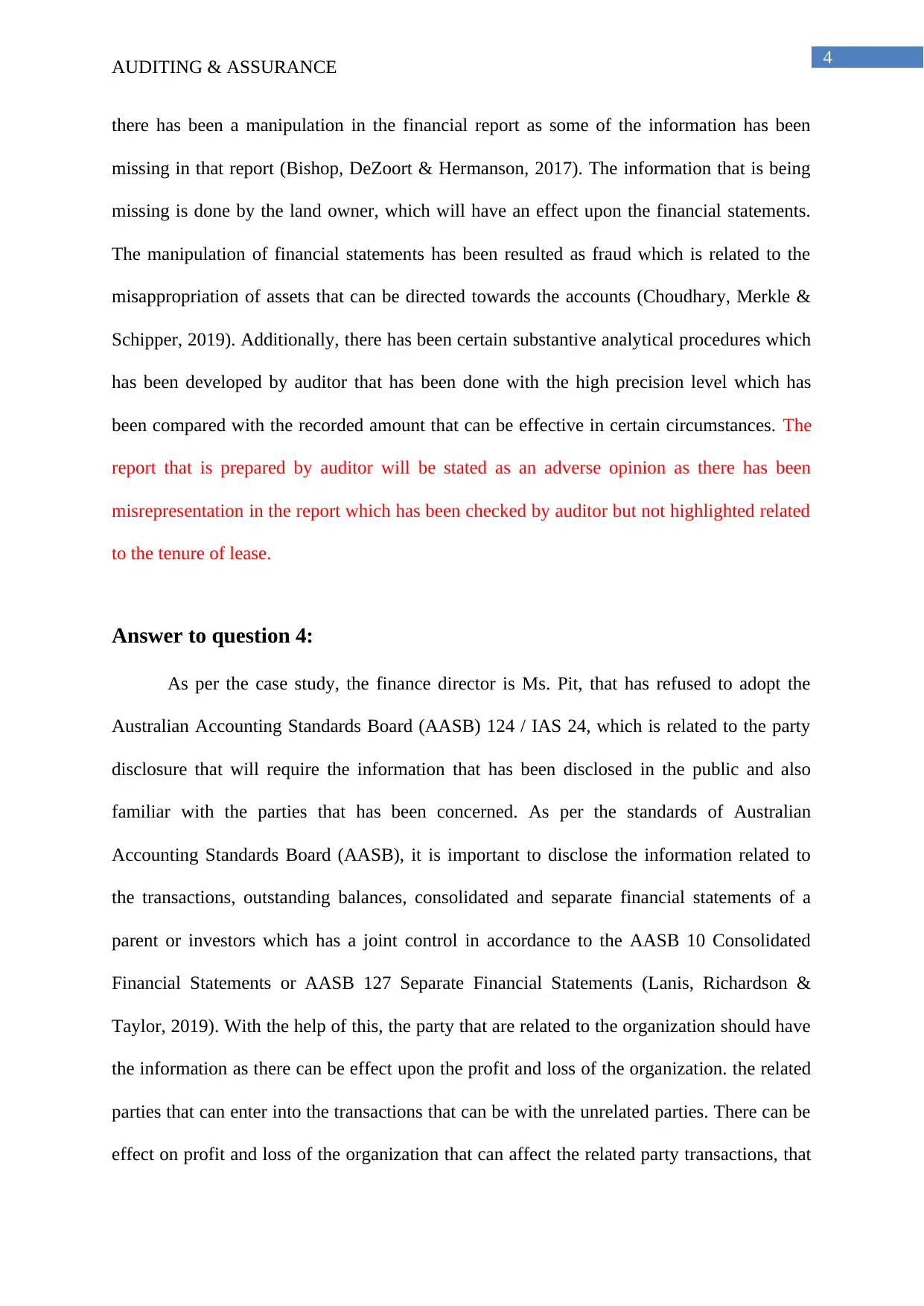
4
AUDITING & ASSURANCE
there has been a manipulation in the financial report as some of the information has been
missing in that report (Bishop, DeZoort & Hermanson, 2017). The information that is being
missing is done by the land owner, which will have an effect upon the financial statements.
The manipulation of financial statements has been resulted as fraud which is related to the
misappropriation of assets that can be directed towards the accounts (Choudhary, Merkle &
Schipper, 2019). Additionally, there has been certain substantive analytical procedures which
has been developed by auditor that has been done with the high precision level which has
been compared with the recorded amount that can be effective in certain circumstances. The
report that is prepared by auditor will be stated as an adverse opinion as there has been
misrepresentation in the report which has been checked by auditor but not highlighted related
to the tenure of lease.
Answer to question 4:
As per the case study, the finance director is Ms. Pit, that has refused to adopt the
Australian Accounting Standards Board (AASB) 124 / IAS 24, which is related to the party
disclosure that will require the information that has been disclosed in the public and also
familiar with the parties that has been concerned. As per the standards of Australian
Accounting Standards Board (AASB), it is important to disclose the information related to
the transactions, outstanding balances, consolidated and separate financial statements of a
parent or investors which has a joint control in accordance to the AASB 10 Consolidated
Financial Statements or AASB 127 Separate Financial Statements (Lanis, Richardson &
Taylor, 2019). With the help of this, the party that are related to the organization should have
the information as there can be effect upon the profit and loss of the organization. the related
parties that can enter into the transactions that can be with the unrelated parties. There can be
effect on profit and loss of the organization that can affect the related party transactions, that
AUDITING & ASSURANCE
there has been a manipulation in the financial report as some of the information has been
missing in that report (Bishop, DeZoort & Hermanson, 2017). The information that is being
missing is done by the land owner, which will have an effect upon the financial statements.
The manipulation of financial statements has been resulted as fraud which is related to the
misappropriation of assets that can be directed towards the accounts (Choudhary, Merkle &
Schipper, 2019). Additionally, there has been certain substantive analytical procedures which
has been developed by auditor that has been done with the high precision level which has
been compared with the recorded amount that can be effective in certain circumstances. The
report that is prepared by auditor will be stated as an adverse opinion as there has been
misrepresentation in the report which has been checked by auditor but not highlighted related
to the tenure of lease.
Answer to question 4:
As per the case study, the finance director is Ms. Pit, that has refused to adopt the
Australian Accounting Standards Board (AASB) 124 / IAS 24, which is related to the party
disclosure that will require the information that has been disclosed in the public and also
familiar with the parties that has been concerned. As per the standards of Australian
Accounting Standards Board (AASB), it is important to disclose the information related to
the transactions, outstanding balances, consolidated and separate financial statements of a
parent or investors which has a joint control in accordance to the AASB 10 Consolidated
Financial Statements or AASB 127 Separate Financial Statements (Lanis, Richardson &
Taylor, 2019). With the help of this, the party that are related to the organization should have
the information as there can be effect upon the profit and loss of the organization. the related
parties that can enter into the transactions that can be with the unrelated parties. There can be
effect on profit and loss of the organization that can affect the related party transactions, that
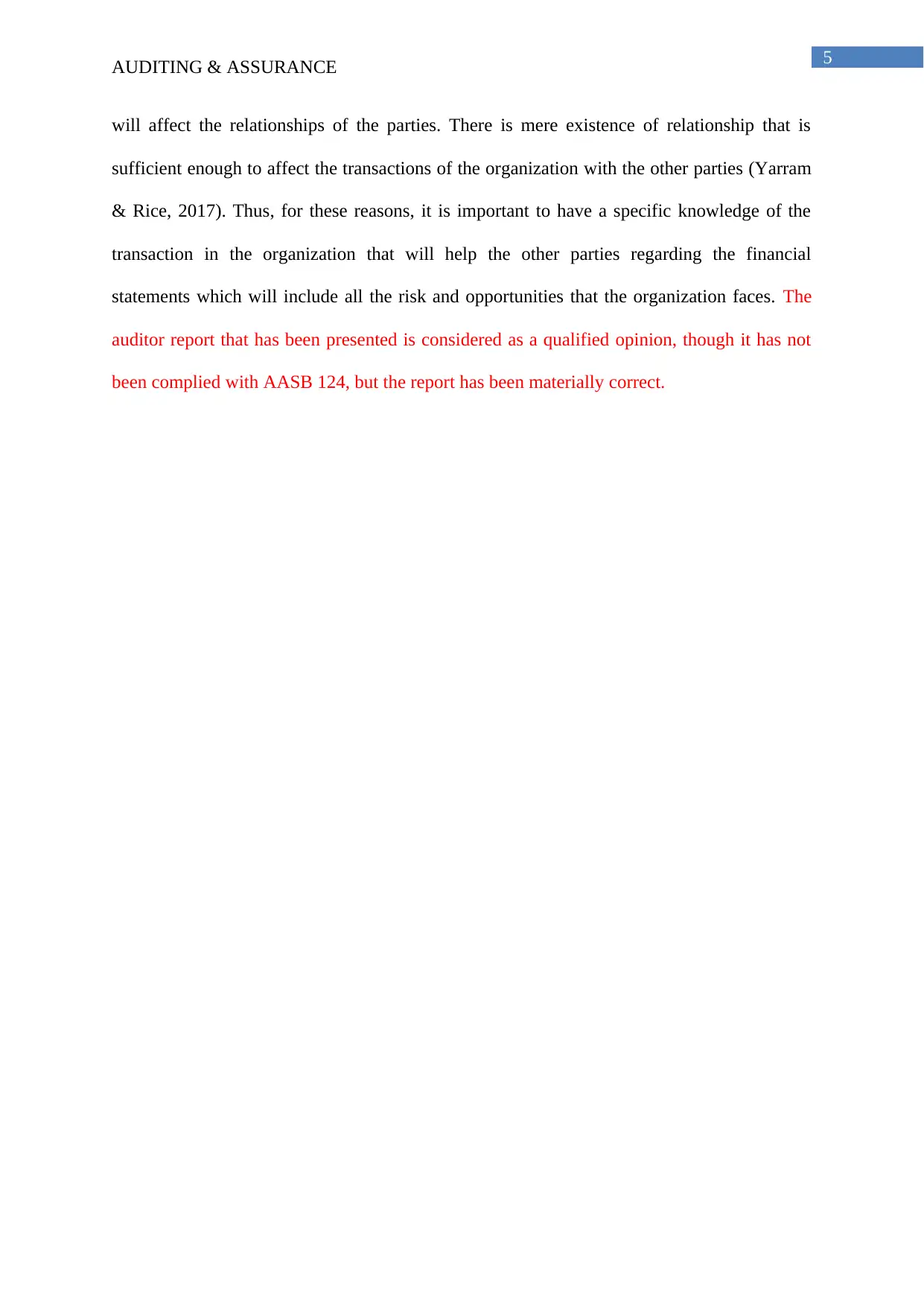
5
AUDITING & ASSURANCE
will affect the relationships of the parties. There is mere existence of relationship that is
sufficient enough to affect the transactions of the organization with the other parties (Yarram
& Rice, 2017). Thus, for these reasons, it is important to have a specific knowledge of the
transaction in the organization that will help the other parties regarding the financial
statements which will include all the risk and opportunities that the organization faces. The
auditor report that has been presented is considered as a qualified opinion, though it has not
been complied with AASB 124, but the report has been materially correct.
AUDITING & ASSURANCE
will affect the relationships of the parties. There is mere existence of relationship that is
sufficient enough to affect the transactions of the organization with the other parties (Yarram
& Rice, 2017). Thus, for these reasons, it is important to have a specific knowledge of the
transaction in the organization that will help the other parties regarding the financial
statements which will include all the risk and opportunities that the organization faces. The
auditor report that has been presented is considered as a qualified opinion, though it has not
been complied with AASB 124, but the report has been materially correct.
⊘ This is a preview!⊘
Do you want full access?
Subscribe today to unlock all pages.

Trusted by 1+ million students worldwide
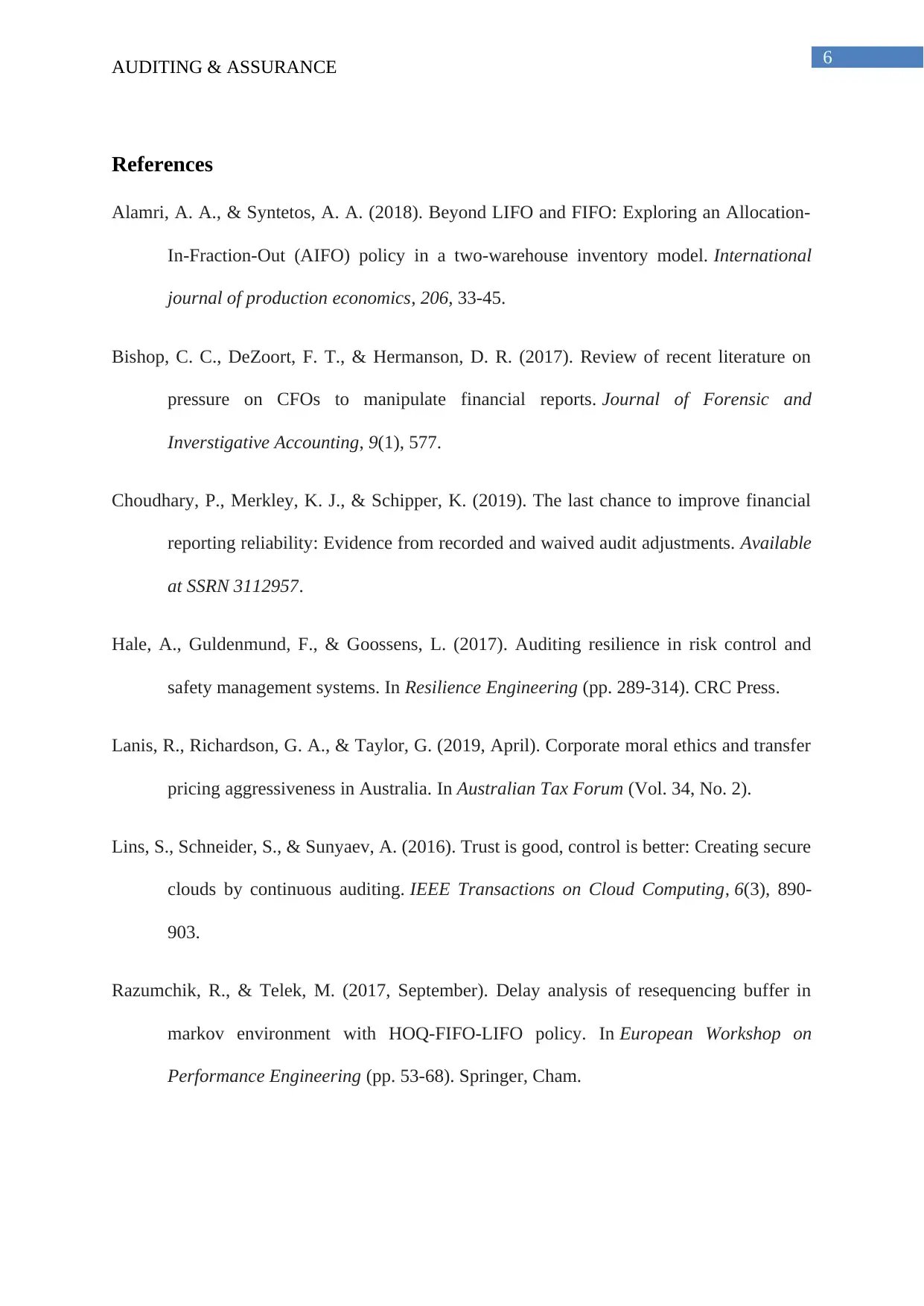
6
AUDITING & ASSURANCE
References
Alamri, A. A., & Syntetos, A. A. (2018). Beyond LIFO and FIFO: Exploring an Allocation-
In-Fraction-Out (AIFO) policy in a two-warehouse inventory model. International
journal of production economics, 206, 33-45.
Bishop, C. C., DeZoort, F. T., & Hermanson, D. R. (2017). Review of recent literature on
pressure on CFOs to manipulate financial reports. Journal of Forensic and
Inverstigative Accounting, 9(1), 577.
Choudhary, P., Merkley, K. J., & Schipper, K. (2019). The last chance to improve financial
reporting reliability: Evidence from recorded and waived audit adjustments. Available
at SSRN 3112957.
Hale, A., Guldenmund, F., & Goossens, L. (2017). Auditing resilience in risk control and
safety management systems. In Resilience Engineering (pp. 289-314). CRC Press.
Lanis, R., Richardson, G. A., & Taylor, G. (2019, April). Corporate moral ethics and transfer
pricing aggressiveness in Australia. In Australian Tax Forum (Vol. 34, No. 2).
Lins, S., Schneider, S., & Sunyaev, A. (2016). Trust is good, control is better: Creating secure
clouds by continuous auditing. IEEE Transactions on Cloud Computing, 6(3), 890-
903.
Razumchik, R., & Telek, M. (2017, September). Delay analysis of resequencing buffer in
markov environment with HOQ-FIFO-LIFO policy. In European Workshop on
Performance Engineering (pp. 53-68). Springer, Cham.
AUDITING & ASSURANCE
References
Alamri, A. A., & Syntetos, A. A. (2018). Beyond LIFO and FIFO: Exploring an Allocation-
In-Fraction-Out (AIFO) policy in a two-warehouse inventory model. International
journal of production economics, 206, 33-45.
Bishop, C. C., DeZoort, F. T., & Hermanson, D. R. (2017). Review of recent literature on
pressure on CFOs to manipulate financial reports. Journal of Forensic and
Inverstigative Accounting, 9(1), 577.
Choudhary, P., Merkley, K. J., & Schipper, K. (2019). The last chance to improve financial
reporting reliability: Evidence from recorded and waived audit adjustments. Available
at SSRN 3112957.
Hale, A., Guldenmund, F., & Goossens, L. (2017). Auditing resilience in risk control and
safety management systems. In Resilience Engineering (pp. 289-314). CRC Press.
Lanis, R., Richardson, G. A., & Taylor, G. (2019, April). Corporate moral ethics and transfer
pricing aggressiveness in Australia. In Australian Tax Forum (Vol. 34, No. 2).
Lins, S., Schneider, S., & Sunyaev, A. (2016). Trust is good, control is better: Creating secure
clouds by continuous auditing. IEEE Transactions on Cloud Computing, 6(3), 890-
903.
Razumchik, R., & Telek, M. (2017, September). Delay analysis of resequencing buffer in
markov environment with HOQ-FIFO-LIFO policy. In European Workshop on
Performance Engineering (pp. 53-68). Springer, Cham.
Paraphrase This Document
Need a fresh take? Get an instant paraphrase of this document with our AI Paraphraser
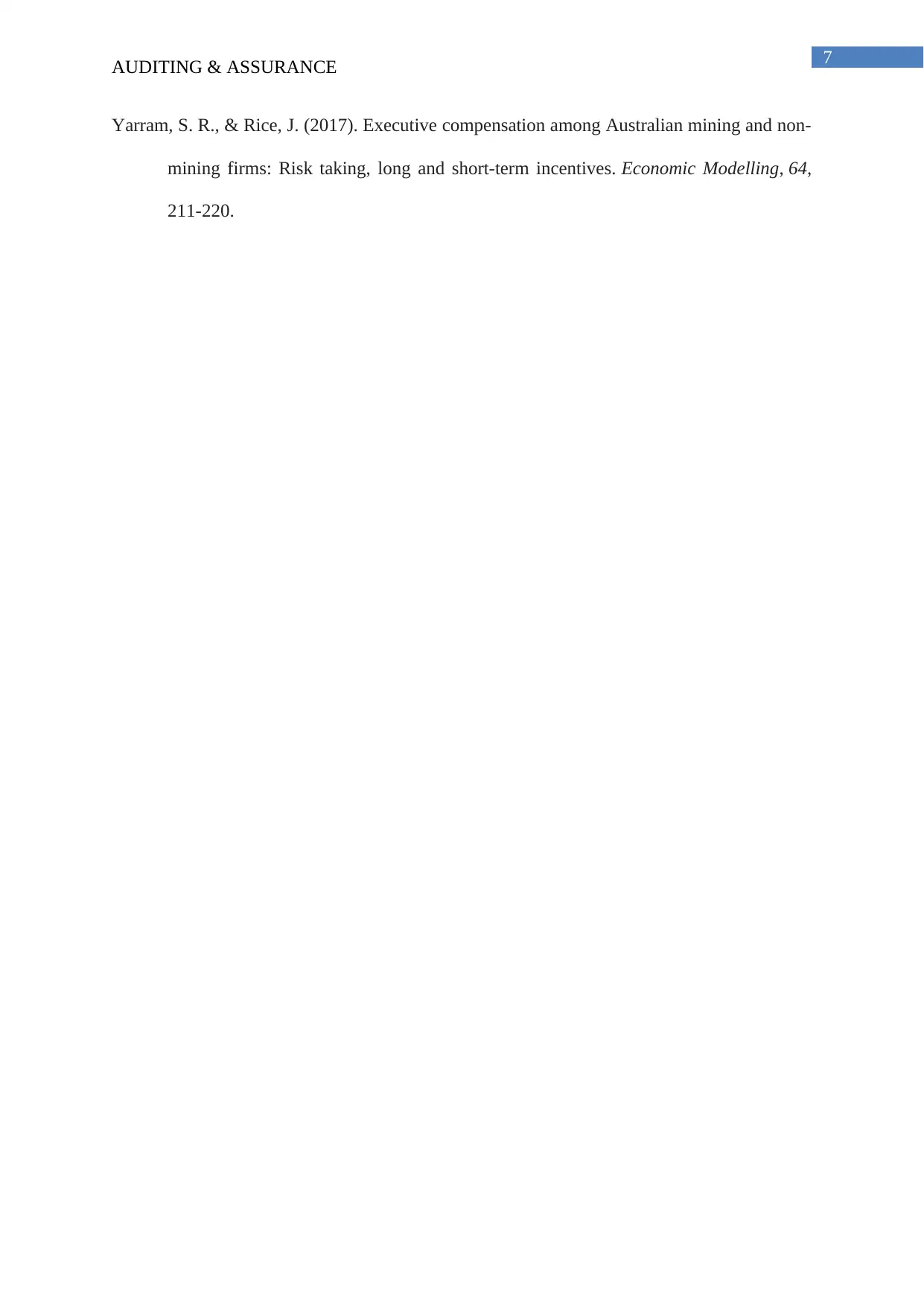
7
AUDITING & ASSURANCE
Yarram, S. R., & Rice, J. (2017). Executive compensation among Australian mining and non-
mining firms: Risk taking, long and short-term incentives. Economic Modelling, 64,
211-220.
AUDITING & ASSURANCE
Yarram, S. R., & Rice, J. (2017). Executive compensation among Australian mining and non-
mining firms: Risk taking, long and short-term incentives. Economic Modelling, 64,
211-220.
1 out of 8
Related Documents
Your All-in-One AI-Powered Toolkit for Academic Success.
+13062052269
info@desklib.com
Available 24*7 on WhatsApp / Email
![[object Object]](/_next/static/media/star-bottom.7253800d.svg)
Unlock your academic potential
Copyright © 2020–2025 A2Z Services. All Rights Reserved. Developed and managed by ZUCOL.





